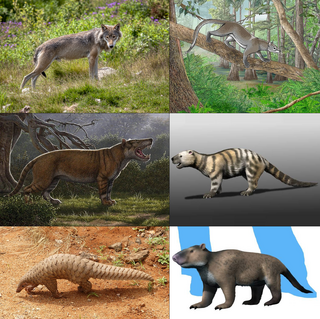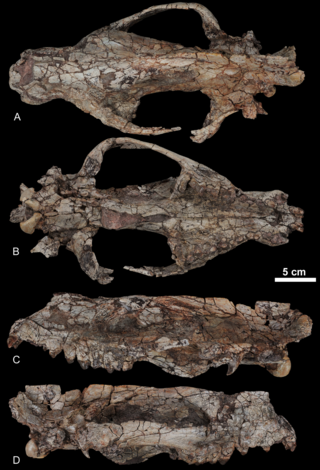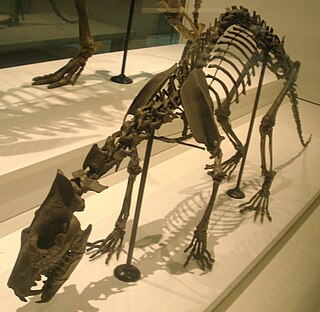
Amphicyonidae is an extinct family of terrestrial carnivorans belonging to the suborder Caniformia. They first appeared in North America in the middle Eocene, spread to Europe by the late Eocene, and further spread to Asia and Africa by the early Miocene. They had largely disappeared worldwide by the late Miocene, with the latest recorded species at the end of the Miocene in Africa. They were among the first carnivorans to evolve large body size. Amphicyonids are colloquially referred to as "bear-dogs".

Ferae is a mirorder of placental mammals from grandorder Ferungulata, that groups together clades Pan-Carnivora, which includes modern carnivorans, and Pholidotamorpha, which includes pangolins.

Viverravidae is an extinct monophyletic family of mammals from extinct superfamily Viverravoidea within the clade Carnivoramorpha, that lived from the early Palaeocene to the late Eocene in North America, Europe and Asia. They were once thought to be the earliest carnivorans and ancestral to extant ones, but now are placed outside the order Carnivora based on cranial morphology as relatives to extant carnivorans.

Miacis is an extinct genus of placental mammals from clade Carnivoraformes, that lived in North America from the early to middle Eocene.

Carnivoramorpha is a clade of placental mammals of clade Pan-Carnivora from mirorder Ferae, that includes the modern order Carnivora and its extinct stem-relatives.

Cormohipparion is an extinct genus of horse belonging to the tribe Hipparionini that lived in North America during the late Miocene to Pliocene. They grew up to 3 feet long.

Vulpavus is an extinct paraphyletic genus of placental mammals from clade Carnivoraformes, that lived in North America from the early to middle Eocene.

Palaearctonyx is an extinct genus of omnivorous placental mammals from clade Carnivoraformes, that lived in North America from the early to middle Eocene.

Vassacyon is an extinct genus of placental mammals from clade Carnivoraformes, that lived in North America and Europe from the late Paleocene to early Eocene. It is considered the largest of the early Eocene mammals.

Merriamosauria is an extinct clade of ichthyosaurs. It was named by Ryosuke Motani in his 1999 analysis of the relationships of ichthyopterygian marine reptiles and was defined in phylogenetic terms as a stem-based taxon including "the last common ancestor of Shastasaurus pacificus and Ichthyosaurus communis, and all of its descendants." The name honours John Campbell Merriam. Based on this definition, Merriamosauria includes most ichthyosaurs except for several Triassic groups such as the clade Mixosauria, the family Cymbospondylidae, and perhaps the family Toretocnemidae. Merriamosaurs are characterized by features in their pectoral girdles and limb bones, including an extensive connection between the scapula and the coracoid bone, the absence of the first metacarpal and the absence of a pisiform bone.
The Willwood Formation is a sedimentary sequence deposited during the late Paleocene to early Eocene, or Clarkforkian, Wasatchian and Bridgerian in the NALMA classification.

Hyainailouros ("hyena-cat") is an extinct polyphyletic genus of hyaenodont belonging to the family Hyainailouridae that lived during the early to middle Miocene, of which there were at least three species spread across Europe, Africa, and Asia.
This paleomammalogy list records new fossil mammal taxa that were described during the year 2014, as well as notes other significant paleomammalogy discoveries and events which occurred during that year.
The Chandler Bridge Formation is a geologic formation in South Carolina. It preserves fossils dating back to the Chattian of the Paleogene period, corresponding to the Arikareean in the NALMA classification. The formation overlies the Ashley Formation and is overlain by the Edisto Formation.
The Mission Valley Formation is a marine sandstone geologic formation in the Mission Valley region of southwestern San Diego County in Southern California.

Hyaenodonta is an extinct order of hypercarnivorous placental mammals of clade Pan-Carnivora from mirorder Ferae. Hyaenodonts were important mammalian predators that arose during the early Paleocene in Europe and persisted well into the late Miocene.

Kerberos ("Cerberus") is an extinct genus of hyainailourid hyaenodonts in the subfamily Hyainailourinae, that lived in Europe. It contains the single species Kerberos langebadreae.

Sinopidae is an extinct family of predatory placental mammals from extinct order Hyaenodonta. Fossil remains of these mammals are known from early to middle Eocene deposits in North America, Europe and Asia.
Pternoconius is an extinct genus of macraucheniid litoptern from the Late Oligocene and Early Miocene of Argentina. Fossils of this genus have been found in the Sarmiento Formation of Argentina.
Moqueguahippus is an extinct genus of notohippid notoungulates that lived during the Late Oligocene of what is now Peru. Fossils of this genus have been found in the Moquegua Formation of Peru, which it was named after.














